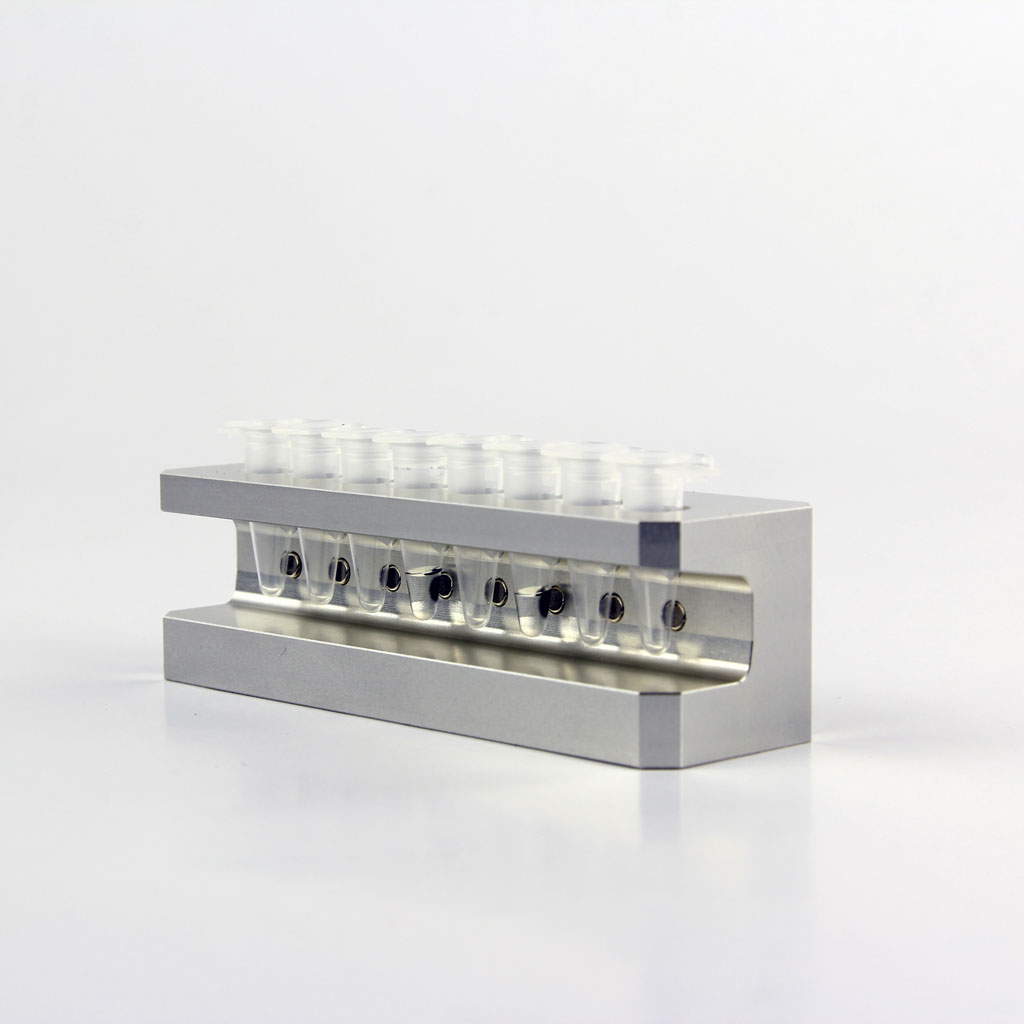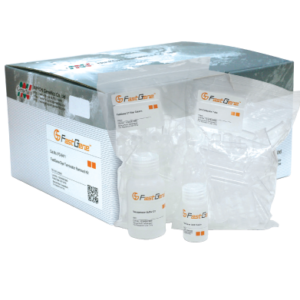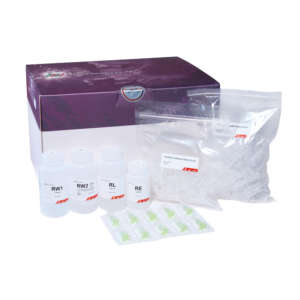Détails
Les billes magnétiques ont longtemps été utilisées pour isoler les acides nucléiques ainsi que les protéines recombinantes. La purification était cependant souvent problématique lorsque le culot était touché ou à cause d’une contamination quand le surnageant n’était pas complètement éliminé.
Le FastGene® MagnaStand résout ces deux problèmes. En créant un culot sur les parois latérales plutôt que vers le bas, le MagnaStand permet avec ses aimants puissants au néodyme de retirer complètement le surnageant sans toucher le culot.
De plus, avec le MagnaStand 1.5, la position verticale est réglable, ce qui permet d’ajuster précisément l’emplacement des aimants sur le tube en fonction du volume utilisé lors de la purification.
Aimants au néodyme pour une attraction plus rapide des particules magnétiques.
Les aimants au néodyme sont les aimants permanents les plus puissants au monde. Les avantages de l’utilisation de tels aimants sont les suivants :
- Séparation très rapide des billes magnétiques de la solution
- Culot stable même en cas de remise en suspension
- Collection complète des billes magnétiques pour moins de perte de matière
Avec la position verticale des aimants, la force magnétique vous donne la solution optimale pour la purification des billes magnétiques.
Magnastand 1,5
Pour les grands volumes et l’utilisation de tubes de 1,5 ml. La position des aimants est ajustable horizontalement et verticalement.
Effectuez jusqu’à 8 purifications en parallèle
Aimants extra larges pour des volumes plus grands
Ajustez la position de l’aimant au volume de votre échantillon
Magnastand 0,2
Pour les purifications de très faibles volumes (jusqu’à 5 µl) en utilisant des tubes PCR normaux. La position horizontale optimale peut être ajustée précisément.
Le FastGene® MagnaStand (FG-SSMAG2) de Nippon Genetics a été implémenté dans le laboratoire de diagnostic de notre institut pour isoler l’ADN génomique de patients, pour un enrichissement de cible SureSelectQXT (Agilent), avant d’être séquencé à l’aide d’un instrument MiSeq (Illumina). Le FastGene® MagnaStand a été utilisé dans toutes les étapes où des billes AMPure XP (BeckmanCoulter) ou Dynabeads (Life Technology) ont été utilisées. La manipulation de FastGene® MagnaStand est très simple et les résultats obtenus jusqu’à présent sont bons. La culot reste, comme désiré, sur le côté de la paroi du tube, permettant un retrait facile du surnageant. Dans certains cas, l’élimination complète de l’élution était possible. Le FastGene® MagnaStand est compact et robuste. Nous en sommes très satisfaits et le recommandons à tout moment !
Simone Rost, PhD – Institut de génétique humaine – Université de Würzburg – Allemagne
- Effectuez jusqu’à 8 purifications en parallèle
- Optimisé pour de petits volumes
- Ajustez la position de l’aimant pour un contact plus proche avec le tube


FAQ
Pouvez-vous me donner quelques données techniques sur le MagnaStand et le classement N des aimants ?
L’aimant au néodyme (également connu sous le nom de NdFeB, NIB ou Neo magnet) est le type d’aimant terres rares le plus largement utilisé. C’est un aimant permanent constitué d’un alliage de néodyme, de fer et de bore pour former la structure cristalline tétragonale Nd2Fe14B. Développé en 1982 par General Motors et Sumitomo Special Metals, l’aimant au néodyme est le type d’aimant permanent le plus puissant du marché. Ces aimants ont remplacé d’autres types d’aimants dans de nombreux produits modernes, tels que les moteurs d’outils sans fil, les disques durs et les attaches magnétiques. Les aimants au néodyme sont classés en fonction de leur produit énergétique maximal, qui correspond au flux magnétique sortant par unité de volume. Des valeurs plus élevées indiquent des aimants plus puissants et vont de N35 à N52. Les lettres qui suivent le grade indiquent les températures maximales de fonctionnement (souvent la température de Curie), comprises entre M (jusqu’à 100 °C) et EH (200 °C).
Que signifie le “classement ou grade N” des aimants au néodyme ?
Le grade, ou indice N de l’aimant fait référence au produit énergétique maximale du matériau constituant l’aimant. Il fait référence à la force maximale à laquelle le matériau peut être magnétisé. Le grade des aimants au néodyme est généralement mesuré en Mega Gauss Oersted (MGOe). Un aimant de grade N42 a un produit énergétique maximal de 42 MGOe. En règle générale, plus le grade est élevé, plus l’aimant est puissant.
Nous pouvons affirmer que pour tous les aimants, l’indice N est “N40”.
Seuls les clients connectés peuvent laisser un avis.










S. Kaulfuß, Institut für Humangenetik Göttingen –
Wir verwenden sowohl den Magnastand 0,2 als auch den 1,5 für die Library-Präparation in unserer Routinediagnostik. Nach Austesten verschiedener Anbieter und auch eines Eigenbaus sind wir mit diesem Produkt hochzufrieden.
Translation from Nippon Genetics:
We use both the MagnaStand for 0.2 and 1.5 ml for the preparation of cDNA libraries. We are very satisfied with this product. Before using the MagnaStand we test several magnetic stands from other companies and a homemade magnetic stand.
Utilisateur vérifié
Marta Borowiec, PhD, Postdoctoral Fellow, University of Warsaw, Centre of New Technologies –
My research involves purifying DNA from a very small sample volume, often in a 96-well format. The first rack I had used a magnet in the form of an O-ring. Unfortunately, it did not work well below 50ul. The shape of the magnet also caused the problem since using it is convenient to support the tip of multichannel pipette on the PCR tubes. The Nippon magnet stands proved to be the perfect solution. Full mobility of the magnet holder makes it possible to adapt it to any volume and model of PCR tubes. In addition, it is possible to purify DNA from different sample volumes, thanks to individually fitted magnets. Another advantage is the possibility of firmly fixing the eppendorf (so that it does not fall out) and setting the entire stand in any position, even upside down. Since the whole stand is made of metal, it is very convenient to elute ssDNA from biotinylated DNA caught on streptavidin by heating the whole to 70°C.
And all this made me a happy owner of 3 different Nippon stands so far 🙂
Utilisateur vérifié
Kazuki Nosho, Max Planck Institute for Terrestrial Microbiology, AG Prof. Drescher –
The MagnaStand works really well. Reliable, effective, easy to use.
Utilisateur vérifié
Carolin Dreier, Institut für Humangenetik, Universitätsklinikum Münster –
Nachdem mir Herr Dr. Oliver Schwarz einen 0.2 MagnaStand zum Testen zur Verfügung gestellt hat war ich total begeistert und orderte direkte mehrere für das ganze Labor. Ich habe mehrere Vergleichsprodukte getestet, aber keines überzeugte so wie der FastGene. Die beads werden punktuell gehalten und die Magnete können mit dem mitgelierfertem Imbusschlüssel genau plaziert werden. Mittlerweile sind die Magnetständer im ganzen Institut vertreten und stehen an jedem Labortisch.
Translation by Nippon Genetics:
Dr. Oliver Schwarz provided us a 0.2 MagnaStand for testing. I was totally excited and ordered several MagnaStands for the whole lab. I tested several comparison products, but none of them was so convincing then the FastGene MagnaStand. The beads are kept punctually, and the magnets can place exactly with the supplied Allen key. Meanwhile, the magnetic stands are represented in the whole institute. Each laboratory table has now a MagnaStand.
Utilisateur vérifié
Postdoc, University Heart Center Freiburg –
This magnet is highly recommended. Very fast clearance of the solution from the magnetic beads, strong magnet, adjustable, easy to handle, more effective than other magnets which we tried before, no bead loss during elution.
Utilisateur vérifié
Lab Manager, Universität Basel –
„Actually Postdoc using it is truly happy with it, she will recommend to anybody will ask“.
Utilisateur vérifié
Herr Gossenreiter, Max F. Perutz Laboratories, Wien –
„Wir haben verschiedene magnetic racks für PCR-tubes verglichen und der FastGene® MagnaStand 0.2 hat uns mit seiner Robustheit, Magnetstärke, Justierbarkeit und dem guten Halt der PCR-tubes überzeugt.“
Utilisateur vérifié
Dr. Yohei Sasagawa, Bioinformatische Forschungsanlage, Rechen- und Kommunikationszentrum, RIKEN, Japan –
“More and more applications are performed using magnetic beads, so that a magnetic stand is required which can handle very small volumes. Especially in the genomics research field, where massively parallel sequencing is performed, it is essential for an ideal magnetic stand that is used for the purification of DNA and RNA, to be compatible with a variety of commercially available PCR tubes and plates.
The available magnetic stands could not capture the magnetic beads firmly or provide an easy handling for the researcher. The handling of the FastGene® MagnaStands is easy, without any loss of magnetic beads during purification even when very few µl of liquid volume were used. Hence, it is the solution for the well-known and common problem of sample loss due to magnetic beads being aspirated by the pipette during a purification using a small sample volume.
The FastGene® MagnaStand 0.2 and the FastGene® MagnaStand 1.5 can be used for the purification of small number of samples.
The FastGene® MagnaStand 96 is useful for the purification of a large number of samples, e.g. for single-cell genomic research.
All FastGene® MagnaStands are the best tool to easily purify magnetic beads from small volumes, since the magnetic beads are firmly held in one position of the tube wall.”
Translation by Nippon Genetics
„Immer mehr Applikationen werden mit Hilfe von Magnetic Beads durchgeführt, so dass Magnetische Stands benötigt werden, die auch sehr kleine Volumen händeln können. Besonders im Bereich der genomischen Forschung, in der äußerst viele parallele Sequenzierungen durchgeführt werden, sind für die DNA und RNA Aufreinigung benutzte magnetische Stands essentiell, die kompatibel mit diversen kommerziell erhältlichen PCR Reaktionsgefäßen und Platten sind.
Die bisher erhältlichen Magnetic Stands konnten die Magnetic Beads nicht gänzlich erfassen oder waren nur schwer bedienbar. Die Handhabung von FastGene® MagnaStands ist einfach und Magnetic Beads gehen während der Aufreinigung nicht einmal dann verloren, wenn nur wenige µl Flüssikeit verwendet werden. Somit sind sie die Lösung für das altbekannte, häufig auftretende Problem des Probeverlustes durch das Einsaugen der Magnetic Beads mit der Pipette bei der Verwendung geringer Probevolumen.
Das FastGene® MagnaStand 0.2 und das FastGene® MagnaStand 1.5 kann für die Aufreinigung einer kleinen Anzahl von Proben verwendet werden.
Das FastGene® MagnaStand 96 ist nützlich für die Aufreinigung einer großen Anzahl von Proben, z.B. für eine Single cell Genomsequenzierung.
Alle FastGene® MagnaStands sind die besten Arbeitshilfen zum Reinigen von Magnetic Beads, die in geringen Volumen vorliegen, da die Magnetic Beads fest in einer Position an der Wand des Raktionsgefäßes gehalten werden.
Dr. Yohei Sasagawa ist ein Forscher der in Zusammenarbeit mit Nippon Genetics die FastGene® MagnaStands für seine NGS Library Präparation entwickelt hat.
Utilisateur vérifié
Frau Dr. Rost, Institut für Humangenetik, Würzburg –
„Der Magnetständer FastGene® MagnaStand 0.2 der Firma Nippon Genetics wird im Diagnostik-Labor unseres Instituts für das SureSelectQXT Target Enrichment (Agilent) von genomischer Patienten-DNA zur Sequenzierung am MiSeq (Illumina) verwendet. Bei folgenden Schritten wird der Magnetständer eingesetzt: während der beiden Aufreinigungsschritte der Library mittels AMPure XP Beads, während der „Capture“-Schritte der hybridisierten DNA mittels Streptavidin-coated Magnetic Beads (Dynabeads von Life Technologie), sowie während der finalen Aufreinigung der amplifizierten Library mittels AMPure XP Beads. Zusammenfassend wird der Magnetständer folglich in jedem Schritt eingesetzt, in dem entweder AMPure Beads oder Dynabeads verwendet werden. Die Dynabeads lassen sich etwas schlechter trennen als die AMPure Beads, aber dieses Problem scheint unabhängig vom verwendeten Magnetständer aufzutreten.“
Translation by Nippon Genetics
“The magnetic stand FastGene® Magna Stand (FG-SSMAG2) from Nippon Genetics was implemented in the diagnostic lab of our institute to isolate genomic DNA from patients, for a SureSelectQXT Target Enrichment (Agilent), before being sequenced using a MiSeq instrument (Illumina). The FastGene® Magna Stand has been used in all steps where AMPure XP beads (BeckmanCoulter) or Dynabeads (Life Technology) were utilized.
The handling of the FastGene® Magna Stands is very easy and the results obtained so far are good. The pellet stays, as desired, at the side of the tube wall, enabling an easy removal of the supernatant. In some cases, the complete removal of the elution was possible. The FastGene® Magna Stand is compact and robust. We are very satisfied with it and would recommend it any time!”
Utilisateur vérifié